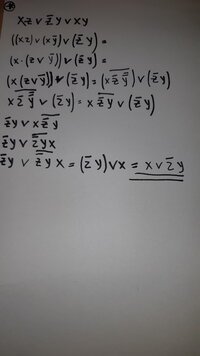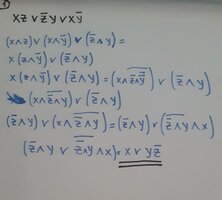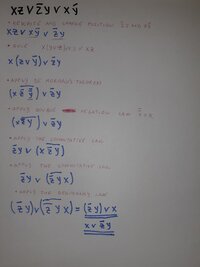logical algebra
- Thread starter Erros
- Start date
Steven G
Elite Member
- Joined
- Dec 30, 2014
- Messages
- 14,591
Your very 1st line is wrong.I don't know if what I did is … good
Is this done well and correctly, the way to reduce to 3 literalsLogical 'and' is commutative, which means that your second answer is identical to the first.
blamocur
Elite Member
- Joined
- Oct 30, 2021
- Messages
- 3,205
IF your second answer is equivalent to your first answer AND your first answer is incorrect THEN you second answer is incorrect too.Is this done well and correctly, the way to reduce to 3 literals
Okay, I understood, but I'm asking what I should fix to make it correct?
IF your second answer is equivalent to your first answer AND your first answer is incorrect THEN you second answer is incorrect too.
blamocur
Elite Member
- Joined
- Oct 30, 2021
- Messages
- 3,205
I could have made mistakes of my own, but it looks like half of your transformations are wrong. In those cases I cannot understand how you get from one line to another. For example, you've modified the first transformation flagged by @Steven G in post #3, but you did not make it right.
My suggestion for you is to write explanations for each transformation so we can check if your understanding of the rules needs corrections. You can start with the first transformation and post it for us to check.
My suggestion for you is to write explanations for each transformation so we can check if your understanding of the rules needs corrections. You can start with the first transformation and post it for us to check.
Dr.Peterson
Elite Member
- Joined
- Nov 12, 2017
- Messages
- 16,809
Does everyone realize that the change from the first answer to the second answer was just that the first line had been wrong at first, and was corrected to match the original statement of the problem?
The answer wasn't changed, only the original form:
I believe the answer (and the work) has been right all along (though I could be missing something).
The answer wasn't changed, only the original form:
I believe the answer (and the work) has been right all along (though I could be missing something).
blamocur
Elite Member
- Joined
- Oct 30, 2021
- Messages
- 3,205
Not sure I agree. While the final answer seems correct the intermediate transformations don't seem so. E.g., in the very first transformation expressions (x∧z)∨(x∧yˉ)∨(zˉ∧y) and x∧(z∧yˉ)∨(zˉ∧y) have different values when x=y=z=TI believe the answer (and the work) has been right all along (though I could be missing something).
Dr.Peterson
Elite Member
- Joined
- Nov 12, 2017
- Messages
- 16,809
You're right. I think I was reading it as it was intended, with an or where an and was written, or something like that. (I don't have time at the moment to look carefully.)Not sure I agree. While the final answer seems correct the intermediate transformations don't seem so. E.g., in the very first transformation expressions (x∧z)∨(x∧yˉ)∨(zˉ∧y) and x∧(z∧yˉ)∨(zˉ∧y) have different values when x=y=z=T
blamocur
Elite Member
- Joined
- Oct 30, 2021
- Messages
- 3,205
I too was too lazy to look carefully, so I wrote a quick script to do the checking(I don't have time at the moment to look carefully.)
blamocur
Elite Member
- Joined
- Oct 30, 2021
- Messages
- 3,205
I did it in detail and fine, is this now exactly final and are these the 3 literals that are required in this task View attachment 34411





